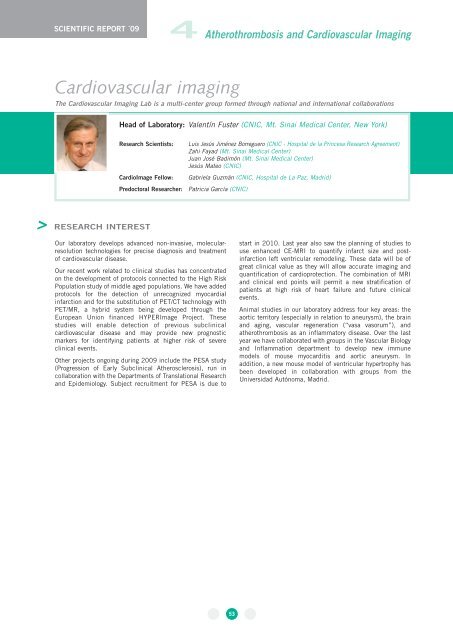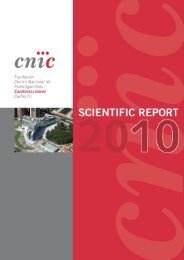Appendix - CNIC
Appendix - CNIC
Appendix - CNIC
Create successful ePaper yourself
Turn your PDF publications into a flip-book with our unique Google optimized e-Paper software.
SCIENTIFIC REPORT ´09<br />
Cardiovascular imaging<br />
> RESEARCH INTEREST<br />
Our laboratory develops advanced non-invasive, molecularresolution<br />
technologies for precise diagnosis and treatment<br />
of cardiovascular disease.<br />
Our recent work related to clinical studies has concentrated<br />
on the development of protocols connected to the High Risk<br />
Population study of middle aged populations. We have added<br />
protocols for the detection of unrecognized myocardial<br />
infarction and for the substitution of PET/CT technology with<br />
PET/MR, a hybrid system being developed through the<br />
European Union financed HYPERImage Project. These<br />
studies will enable detection of previous subclinical<br />
cardiovascular disease and may provide new prognostic<br />
markers for identifying patients at higher risk of severe<br />
clinical events.<br />
Other projects ongoing during 2009 include the PESA study<br />
(Progression of Early Subclinical Atherosclerosis), run in<br />
collaboration with the Departments of Translational Research<br />
and Epidemiology. Subject recruitment for PESA is due to<br />
4 Atherothrombosis and Cardiovascular Imaging<br />
The Cardiovascular Imaging Lab is a multi-center group formed through national and international collaborations<br />
Head of Laboratory: Valentín Fuster (<strong>CNIC</strong>, Mt. Sinai Medical Center, New York)<br />
Research Scientists: Luis Jesús Jiménez Borreguero (<strong>CNIC</strong> - Hospital de la Princesa Research Agreement)<br />
Zahi Fayad (Mt. Sinai Medical Center)<br />
Juan José Badimón (Mt. Sinai Medical Center)<br />
Jesús Mateo (<strong>CNIC</strong>)<br />
CardioImage Fellow: Gabriela Guzmán (<strong>CNIC</strong>, Hospital de La Paz, Madrid)<br />
Predoctoral Researcher: Patricia García (<strong>CNIC</strong>)<br />
53<br />
start in 2010. Last year also saw the planning of studies to<br />
use enhanced CE-MRI to quantify infarct size and postinfarction<br />
left ventricular remodeling. These data will be of<br />
great clinical value as they will allow accurate imaging and<br />
quantification of cardioprotection. The combination of MRI<br />
and clinical end points will permit a new stratification of<br />
patients at high risk of heart failure and future clinical<br />
events.<br />
Animal studies in our laboratory address four key areas: the<br />
aortic territory (especially in relation to aneurysm), the brain<br />
and aging, vascular regeneration (“vasa vasorum”), and<br />
atherothrombosis as an inflammatory disease. Over the last<br />
year we have collaborated with groups in the Vascular Biology<br />
and Inflammation department to develop new immune<br />
models of mouse myocarditis and aortic aneurysm. In<br />
addition, a new mouse model of ventricular hypertrophy has<br />
been developed in collaboration with groups from the<br />
Universidad Autónoma, Madrid.



